(AKC Terrier Group)
 Graceful and lithe in appearance, the Bedlington Terrier has a big
heart and loveable nature. The breed is best known for its curly,
woolly coat which starts out dark in puppyhood and fades to a pale
bluish gray, sandy or liver, giving him the appearance of a lamb.
Graceful and lithe in appearance, the Bedlington Terrier has a big
heart and loveable nature. The breed is best known for its curly,
woolly coat which starts out dark in puppyhood and fades to a pale
bluish gray, sandy or liver, giving him the appearance of a lamb.
General Appearance
A graceful, lithe, well-balanced dog with no sign of coarseness, weakness or shelliness. In repose the expression is mild and gentle, not shy or nervous. Aroused, the dog is particularly alert and full of immense energy and courage. Noteworthy for endurance, Bedlingtons also gallop at great speed, as their body outline clearly shows.
 Head
Head
Narrow, but deep and rounded. Shorter in skull and longer in jaw. Covered with a profuse topknot which is lighter than the color of the body, highest at the crown, and tapering gradually to just back of the nose. There must be no stop and the unbroken line from crown to nose end reveals a slender head without cheekiness or snipiness. Lips are black in the blue and blue and tans and brown in all other solid and bi-colors. Eyes - Almond-shaped, small, bright and well sunk with no tendency to tear or water. Set is oblique and fairly high on the head. Blues have dark eyes; blues and tans, less dark with amber lights; sandies, sandies and tans, light hazel; livers, livers and tans, slightly darker. Eye rims are black in the blue and blue and tans, and brown in all other solid and bi-colors. Ears - Triangular with rounded tips. Set on low and hanging flat to the cheek in front with a slight projection at the base. Point of greatest width approximately 3 inches. Ear tips reach the corners of the mouth. Thin and velvety in texture, covered with fine hair forming a small silky tassel at the tip. Nose - Nostrils large and well defined. Blues and blues and tans have black noses. Livers, livers and tans, sandies, sandies and tans have brown noses. Jaws - Long and tapering. Strong muzzle well filled up with bone beneath the eye. Close-fitting lips, no flews. Teeth - Large, strong and white. Level or scissors bite. Lower canines clasp the outer surface of the upper gum just in front of the upper canines. Upper premolars and molars lie outside those of the lower jaw.
Neck and Shoulders
Long, tapering neck with no throatiness, deep at the base and rising well up from the shoulders which are flat and sloping with no excessive musculature. The head is carried high.
Body
Muscular and markedly flexible. Chest deep. Flat-ribbed and deep through the brisket, which reaches to the elbows. Back has a good natural arch over the loin, creating a definite tuck-up of the underline. Body slightly greater in length than height. Well-muscled quarters are also fine and graceful.
Legs and Feet
Lithe and muscular. The hind legs are longer than the forelegs, which are straight and wider apart at the chest than at the feet. Slight bend to pasterns which are long and sloping without weakness. Stifles well angulated. Hocks strong and well let down, turning neither in nor out. Long hare feet with thick, well-closed-up, smooth pads. Dewclaws should be removed.
Coat
A very distinctive mixture of hard and soft hair standing well out from the skin. Crisp to the touch but not wiry, having a tendency to curl, especially on the head and face. When in show trim must not exceed 1 inch on body; hair on legs is slightly longer.
Tail
Set low, scimitar-shaped, thick at the root and tapering to a point which reaches the hock. Not carried over the back or tight to the underbody.
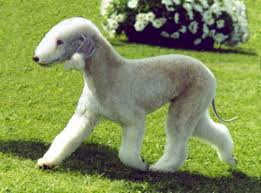 Color
Color
Blue, sandy, liver, blue and tan, sandy and tan, liver and tan. In bi-colors the tan markings are found on the legs, chest, under the tail, inside the hindquarters and over each eye. The topknots of all adults should be lighter than the body color. Patches of darker hair from an injury are not objectionable, as these are only temporary. Darker body pigmentation of all colors is to be encouraged.
Height
The preferred Bedlington Terrier dog measures 16½ inches at the withers, the bitch 15½ inches. Under 16 inches or over 17½ inches for dogs and under 15 inches or over 16½ inches for bitches are serious faults. Only where comparative superiority of a specimen outside these ranges clearly justifies it, should greater latitude be taken.
Weight
To be proportionate to height within the range of 17 to 23 pounds.
Gait
Unique lightness of movement. Springy in the slower paces, not stilted or hackneyed. Must not cross, weave or paddle. Approved September 12, 1967
Bedlington Terrier owners in the UK reported that the most common health issues among living dogs were reproductive (primarily of concern to breeders), heart murmur, and eye problems such as epiphora and cataracts. Copper toxicosis occurred among about 5% of living dogs. Bedlington Terriers historically had an unusually high incidence of copper toxicosis, an inherited autosomal recessive disease, characterized by accumulation of excess copper in the liver. Genetic testing is now available, and the disease has been largely eradicated from the Bedlington population in the United States. Active disease (rather than inheritance) is diagnosed with a liver biopsy. It is essential that anyone interested in purchasing a Bedlington is provided with proof of the dogs' unaffected status. All reputable breeders will be able to provide you with proof of DNA or biopsy testing of the parents.
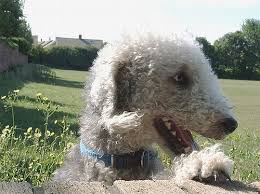 Calmer and less boisterous than many other terriers, the Bedlington
Terrier is known as a dog with a good nature and mild manners. In addition, it is fearless and fast enough to bay a badger or a fox, quick and agile enough to course a hare and is a first-rate water dog.
Incredibly smart and attentive to its owner, the Bedlington is one of
the most reliable terriers. They are problem solvers and loyal family
companions.
Calmer and less boisterous than many other terriers, the Bedlington
Terrier is known as a dog with a good nature and mild manners. In addition, it is fearless and fast enough to bay a badger or a fox, quick and agile enough to course a hare and is a first-rate water dog.
Incredibly smart and attentive to its owner, the Bedlington is one of
the most reliable terriers. They are problem solvers and loyal family
companions.
Like most dogs, if left alone with nothing to do they can become destructive and need exercise; however, they make good dogs for small homes like apartments as long as they get walks and attention. They can make cheerful, lovely companions, and are eager to please.
The famed progenitor of Bedlington was a dog named "Old Flint", whelped in 1782 and owned by "Squire Trevelyan." Originally, the breed was known as the "Rothbury" or "Rodbery Terrier." This name derived from a famous bitch brought from Staffordshire by a company of nail makers who settled in Rothbury. The Terriers of this section were accustomed to rodent hunting underground, and worked with packs of foxhounds kept there at the time.
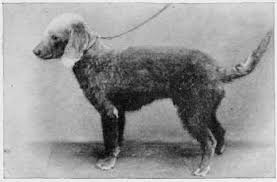 It is suggested that the Bedlington may well have made its way to Ireland and played a part in the early development of the Kerry Blue Terrier.
It is suggested that the Bedlington may well have made its way to Ireland and played a part in the early development of the Kerry Blue Terrier.
The first Bedlington Terrier club was formed in 1877. The Bedlington Terrier was recognized by the United Kennel Club in 1948.
Ch. Femars' Cable Car, descendant of Ch. Rock Ridge Night Rocket winner of best-in-show at the Westminster Kennel Club Dog Show in 1948, was featured on the cover of Sports Illustrated in the February 8, 1960 edition.
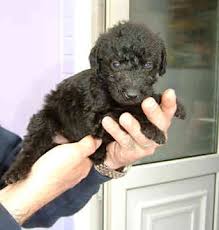
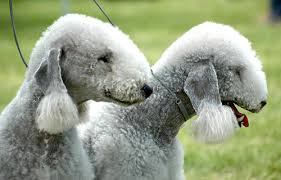
Bedlington Terrier AKC Standards
General Appearance
A graceful, lithe, well-balanced dog with no sign of coarseness, weakness or shelliness. In repose the expression is mild and gentle, not shy or nervous. Aroused, the dog is particularly alert and full of immense energy and courage. Noteworthy for endurance, Bedlingtons also gallop at great speed, as their body outline clearly shows.
Narrow, but deep and rounded. Shorter in skull and longer in jaw. Covered with a profuse topknot which is lighter than the color of the body, highest at the crown, and tapering gradually to just back of the nose. There must be no stop and the unbroken line from crown to nose end reveals a slender head without cheekiness or snipiness. Lips are black in the blue and blue and tans and brown in all other solid and bi-colors. Eyes - Almond-shaped, small, bright and well sunk with no tendency to tear or water. Set is oblique and fairly high on the head. Blues have dark eyes; blues and tans, less dark with amber lights; sandies, sandies and tans, light hazel; livers, livers and tans, slightly darker. Eye rims are black in the blue and blue and tans, and brown in all other solid and bi-colors. Ears - Triangular with rounded tips. Set on low and hanging flat to the cheek in front with a slight projection at the base. Point of greatest width approximately 3 inches. Ear tips reach the corners of the mouth. Thin and velvety in texture, covered with fine hair forming a small silky tassel at the tip. Nose - Nostrils large and well defined. Blues and blues and tans have black noses. Livers, livers and tans, sandies, sandies and tans have brown noses. Jaws - Long and tapering. Strong muzzle well filled up with bone beneath the eye. Close-fitting lips, no flews. Teeth - Large, strong and white. Level or scissors bite. Lower canines clasp the outer surface of the upper gum just in front of the upper canines. Upper premolars and molars lie outside those of the lower jaw.
Neck and Shoulders
Long, tapering neck with no throatiness, deep at the base and rising well up from the shoulders which are flat and sloping with no excessive musculature. The head is carried high.
Body
Muscular and markedly flexible. Chest deep. Flat-ribbed and deep through the brisket, which reaches to the elbows. Back has a good natural arch over the loin, creating a definite tuck-up of the underline. Body slightly greater in length than height. Well-muscled quarters are also fine and graceful.
Legs and Feet
Lithe and muscular. The hind legs are longer than the forelegs, which are straight and wider apart at the chest than at the feet. Slight bend to pasterns which are long and sloping without weakness. Stifles well angulated. Hocks strong and well let down, turning neither in nor out. Long hare feet with thick, well-closed-up, smooth pads. Dewclaws should be removed.
Coat
A very distinctive mixture of hard and soft hair standing well out from the skin. Crisp to the touch but not wiry, having a tendency to curl, especially on the head and face. When in show trim must not exceed 1 inch on body; hair on legs is slightly longer.
Tail
Set low, scimitar-shaped, thick at the root and tapering to a point which reaches the hock. Not carried over the back or tight to the underbody.
Blue, sandy, liver, blue and tan, sandy and tan, liver and tan. In bi-colors the tan markings are found on the legs, chest, under the tail, inside the hindquarters and over each eye. The topknots of all adults should be lighter than the body color. Patches of darker hair from an injury are not objectionable, as these are only temporary. Darker body pigmentation of all colors is to be encouraged.
Height
The preferred Bedlington Terrier dog measures 16½ inches at the withers, the bitch 15½ inches. Under 16 inches or over 17½ inches for dogs and under 15 inches or over 16½ inches for bitches are serious faults. Only where comparative superiority of a specimen outside these ranges clearly justifies it, should greater latitude be taken.
Weight
To be proportionate to height within the range of 17 to 23 pounds.
Gait
Unique lightness of movement. Springy in the slower paces, not stilted or hackneyed. Must not cross, weave or paddle. Approved September 12, 1967
Bedlington Terrier Health Issues
Bedlington Terrier owners in the UK reported that the most common health issues among living dogs were reproductive (primarily of concern to breeders), heart murmur, and eye problems such as epiphora and cataracts. Copper toxicosis occurred among about 5% of living dogs. Bedlington Terriers historically had an unusually high incidence of copper toxicosis, an inherited autosomal recessive disease, characterized by accumulation of excess copper in the liver. Genetic testing is now available, and the disease has been largely eradicated from the Bedlington population in the United States. Active disease (rather than inheritance) is diagnosed with a liver biopsy. It is essential that anyone interested in purchasing a Bedlington is provided with proof of the dogs' unaffected status. All reputable breeders will be able to provide you with proof of DNA or biopsy testing of the parents.
Bedlington Terrier Temperament
Like most dogs, if left alone with nothing to do they can become destructive and need exercise; however, they make good dogs for small homes like apartments as long as they get walks and attention. They can make cheerful, lovely companions, and are eager to please.
Did You Know?
- According to some accounts, the breed was used by gypsies and poachers to catch game on the land of the gentry.
- The "gypsy dog" came to the attention of Lord Rothbury of the town of Bedlington in Northumberland County. He became such an enthusiast of the little dog that the breed became known as Rothbury's Terrier (or Rothbury's Lamb).
- It shares certain similarities, and therefore possibly common ancestry, with the Dandie Dinmont, Kerry Blue, and Soft Coated Wheaten Terriers. Its arched back hints that the Whippet may have also been used to add speed and litheness to the breed's performance ability.
- The first dog to be called a "Bedlington Terrier" was whelped in 1825. The dog was Ainsley's Piper, who started to hunt at 8 months and continued to bring down the most ferocious of otters and badgers even in his blind and toothless old age.
- Joseph Ainsley of Bedlington owned the first dog known to be called a Bedlington Terrier.
- The breed was originally bred in England for hunting.
Bedlington Terrier History
The famed progenitor of Bedlington was a dog named "Old Flint", whelped in 1782 and owned by "Squire Trevelyan." Originally, the breed was known as the "Rothbury" or "Rodbery Terrier." This name derived from a famous bitch brought from Staffordshire by a company of nail makers who settled in Rothbury. The Terriers of this section were accustomed to rodent hunting underground, and worked with packs of foxhounds kept there at the time.
The first Bedlington Terrier club was formed in 1877. The Bedlington Terrier was recognized by the United Kennel Club in 1948.
Ch. Femars' Cable Car, descendant of Ch. Rock Ridge Night Rocket winner of best-in-show at the Westminster Kennel Club Dog Show in 1948, was featured on the cover of Sports Illustrated in the February 8, 1960 edition.
Bedlington Terrier Pics
AKC Registered Breeders
Bedlington Terrier
Parent Club:Bedlington Terrier Club of America
Breeder Referral: website
Breeder Directory: website
Parent Club:Bedlington Terrier Club of America
Breeder Referral: website
Breeder Directory: website
No comments:
Post a Comment